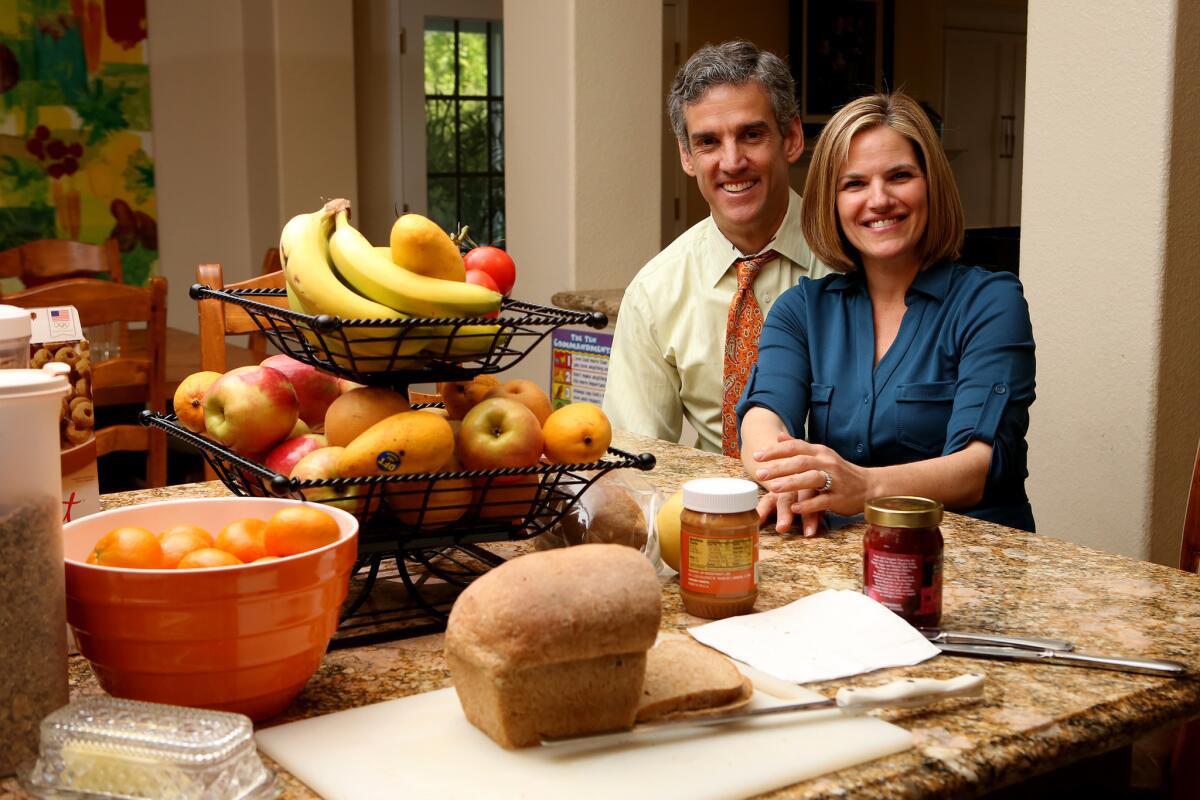Why Loma Linda residents live longer than the rest of us: They treat the body like a temple

Daniel and Vicki Fontoura are among the thousands of Seventh-day Adventists who live in Loma Linda. The Adventists believe in taking care of one’s body and eschewing alcohol and tobacco. Many are vegetarian. The church’s teachings are among the reasons why Loma Linda has the Blue Zone distinction of having more long-living, healthy residents than usual.
- Share via
It’s not a bathing-suit body that Daniel and Vicki Fontoura and their neighbors are after as they go about their days in perhaps the healthiest community in the United States. It’s something so much more essential, a part of their very being.
The Fontouras, their three children and Daniel’s parents are among the 22,000 residents of Loma Linda, where as many as a third of the people are Seventh-day Adventists. Their faith instructs them to treat their bodies as temples: little or no meat or fish, no smoking or alcohol, plenty of exercise and a sense of purpose.
Spend a little time in Loma Linda, and what distinguishes it from, say, the adjacent city of San Bernardino becomes apparent.
The Loma Linda Market near Loma Linda University has bin after bin of beans and grains; there’s no meat section. There is a McDonald’s in a shopping center, but it moved in only after a fight; the arches are demure, and a countertop poster advertises veggie burgers.
On a residential street, tables piled with grapefruit and oranges for sale — on the honor system — sit outside houses. Sixteen-year-old Claire Fontoura says there are few overweight students at her Adventist high school. The cafeteria at Loma Linda University is vegetarian. Students attend chapel every Wednesday to, as the chaplain put it one recent morning, “stop stressing about tests, stop texting ... put away our to-do lists.” And the campus fitness center, and its programs on diet and exercise, are open to the community.
Studies have shown that Seventh-day Adventists, who have a broad range of ethnic backgrounds, live as much as a decade longer than the rest of us, which led to Loma Linda being identified as one of five longevity spots, called Blue Zones, on the planet and the only one in the United States.
“I don’t think we’re so bold as to say that the only way to have this eight- to 10-year advantage is to be an Adventist,” said Fontoura, vice president/chief wholeness officer at Loma Linda University Health. “We do view it as the core. But how people get there is up to them.”
Active longer
At 100, Benita Welebir is chatty and observant. What’s extraordinary about her longevity is that it’s not. In Loma Linda, she’s just another active old person.
One of her neighbors at the Linda Valley Villa is 101, another is 100, and several belong to the 95-plus club. After the morning exercise class, several residents take a walk outside; others gather in the common area of the senior apartment building. (According to census data, just 55,000 Americans reach 100; that’s .02% of us.)
“I am extremely energetic, but I also believe in full rest. If you have full rest, you can go like a little speedster,” Welebir says.
The mother of five says her legs are wearing out a bit. That may be, but she walks the halls at the 100-unit Linda Valley Villa half a mile at a time. She does her own hair.
“I’ve always been happy, and if I’m sad, I know I’ll be happy again.”
Low-meat diets
At 6:30 one morning in the Fontoura family kitchen, there’s lots to eat: a two-tiered server full of mangoes, bananas and oranges; hot rice cereal, whole-grain bread made and brought over that morning by Fontoura’s mother. When 10-year-old Caleb adds jam, it’s a veneer not a slather. Everyone says grace before they eat.
Vicki, who teaches nursing, and Carsten, 8, are pescatarians; Caleb, 10, and Claire are vegetarians; Caleb is pretty adamant, “really dogging me” over an occasional chicken order at Chipotle, Fontoura says.
The Fontouras live in a roomy tract house on the east side of Loma Linda, and everywhere there are family photos. The parents belong to the Lopers, a running club; the children participate in sports.
Saturday is the Sabbath, time off from jobs and homework. The family goes to church and might gather with other families for potluck meals, go to the beach or take a hike. They relax and rejuvenate.
“The Adventist experience is only 20% or 30% healthier than the average American,” says Dan Buettner, the founder of the Blue Zones organization and author of books about the phenomenon. “If you ask most Adventists who their friends are, 80 or 90% are other Adventists. ... You’re less likely to engage in risky behavior because of your religion and more likely to be cared for when you’re older.”
‘Health ministry’
Fontoura’s job is to think strategically and deliberately on how the hospitals’ and college programs can share what they’ve learned about health.
“I think we view our church as blessed with a special health ministry,” he says. “How do we impact the world in positive ways?” The Wholeness Institute, part of Loma Linda University Health, was created to be more deliberate in answering that question, being mindful of other faith traditions. One challenge is to figure out the factors that can accomplish the most — perhaps working to reduce hospital readmissions, reduce stress, increase faith-based commitments.
“We are surrounded by what could be considered gray zones” of poverty, of food and of a built environment that discourages physical activity, he says. The San Bernardino-Ontario-Riverside area has some of the highest poverty rates in the state.
“What are the factors that if they were teased out would be really effective?” Fontoura asks. “What are we doing that is sustainable, scalable?”
For one, a new $68-million campus in San Bernardino aims to provide healthcare and training in medical professions — a way for Loma Linda to, as Fontoura puts it, move an integrated life “from personal to family, community and the world. We’re not here by accident.”
::
A wealth of health data at Loma Linda University
Loma Linda University, owned and operated by the Seventh-day Adventist Church, has collected mountains of data from thousands of people over decades in the Adventist Health Studies. Because the faith frowns on smoking, study participants provided a control group for studies on the effects of tobacco, for example. They showed that a 30-year-old Adventist man is likely to live more than seven years longer than the average white California man. For women, it was a 4.4-year difference. The differences were greater for vegetarian Adventists.
The studies have helped show the beneficial effects of nuts on heart disease, which was a bit of a surprise at the height of the low-fat craze. A study of church members published earlier this year found that vegetarians were 22% less likely than meat eaters to be diagnosed with colon or rectal cancers.
About 96,000 people have been enrolled in an ongoing study, and 26% of them are African American, a generally under-studied population, says Dr. Michael Orlich, who specializes in preventive medicine and is studying the effects of lifestyle on mortality at Loma Linda University Medical Center, part of the 110-year-old Loma Linda University Health System, which includes eight professional schools and six hospitals
Loma Linda also has started to study how an active faith affects overall resilience.
“Health reform was in the DNA of the Seventh-day Adventists,” Orlich says.
But even in Loma Linda, there’s only so much that can be controlled. Also under study, Orlich says, is the effect of smog. Loma Linda sits at the base of mountains all too frequently obscured by haze. The early information, he says, “looks pretty scary, to tell you the truth.”
More to Read
Sign up for Essential California
The most important California stories and recommendations in your inbox every morning.
You may occasionally receive promotional content from the Los Angeles Times.










